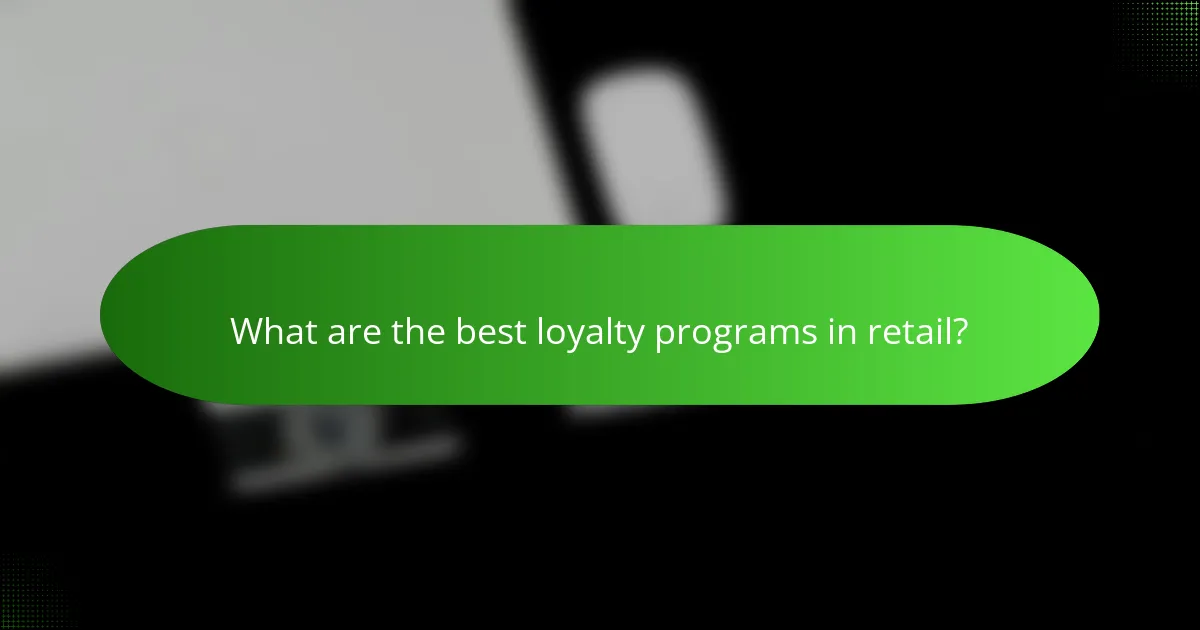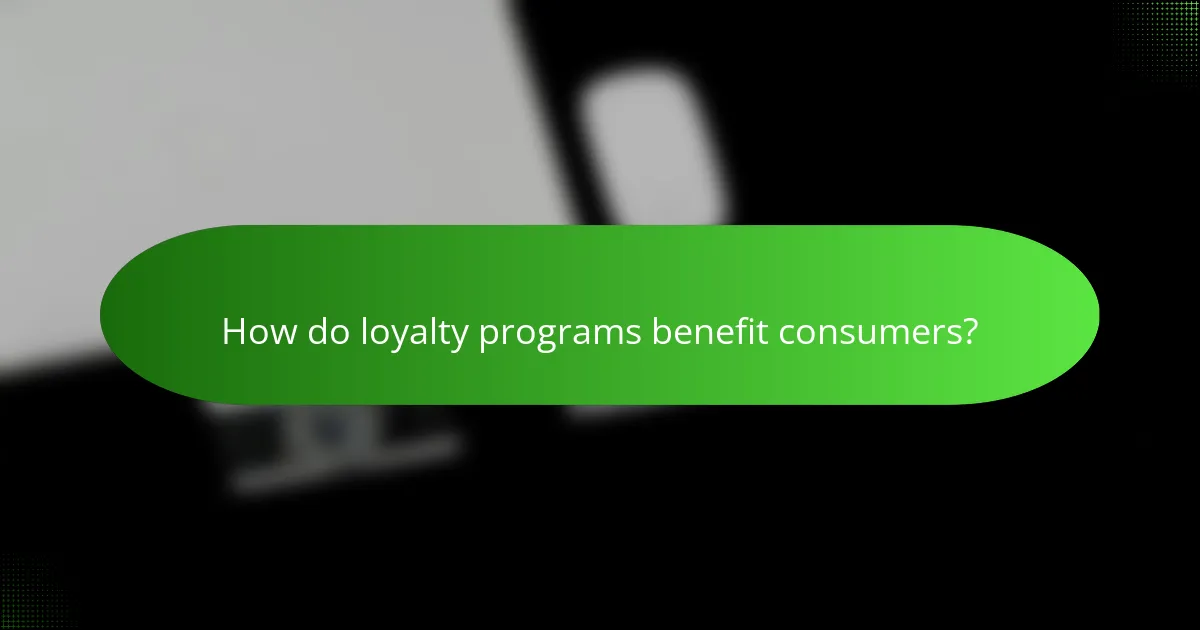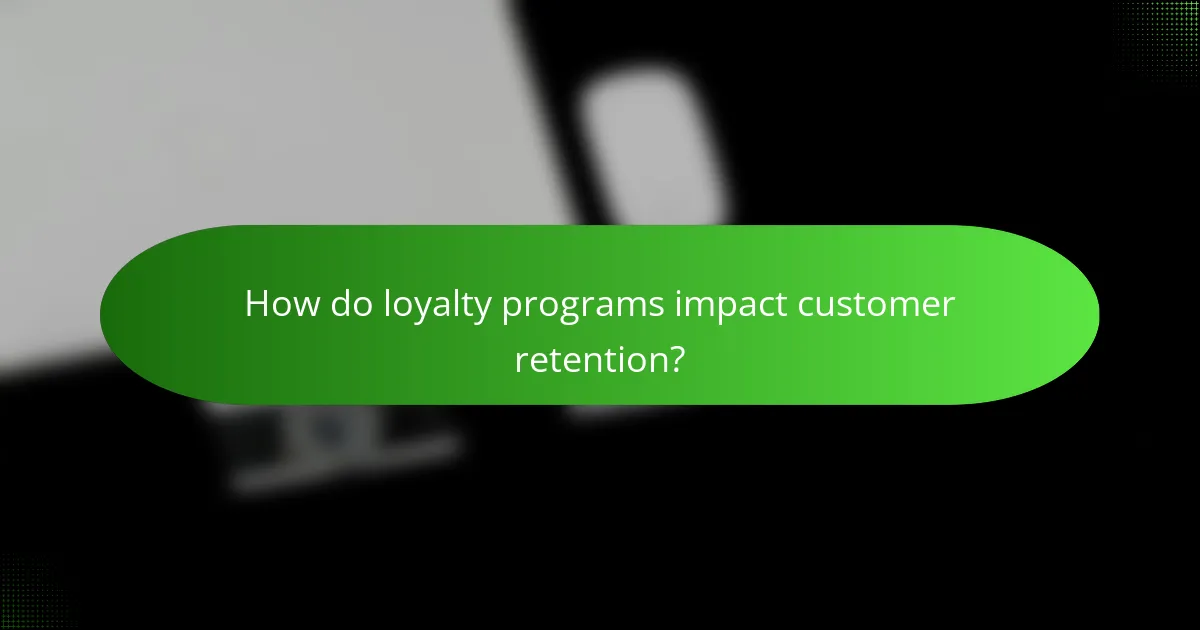Loyalty programs have become essential across various industries, providing customers with incentives that enhance their shopping and travel experiences. In retail, programs like Starbucks Rewards and Amazon Prime offer unique benefits that foster customer retention, while the hospitality sector rewards frequent guests with points redeemable for upgrades and exclusive services. By comparing these programs, we can better understand how they cater to consumer needs and drive brand loyalty.

What are the best loyalty programs in retail?
The best loyalty programs in retail offer customers rewards for their purchases, enhancing customer retention and satisfaction. Programs like Starbucks Rewards, Amazon Prime, and Sephora Beauty Insider stand out due to their unique benefits and structures.
Starbucks Rewards
Starbucks Rewards allows customers to earn stars for every purchase, which can be redeemed for free drinks and food items. Members can also enjoy exclusive offers and early access to new products. The program is accessible via the Starbucks app, making it easy to track rewards and make orders.
To maximize benefits, consider using the app for mobile orders, which can earn additional stars. Avoid letting your stars expire by redeeming them before the deadline, typically within six months of earning them.
Amazon Prime
Amazon Prime is a subscription-based loyalty program that offers various perks, including free shipping, access to streaming services, and exclusive discounts. The annual fee can be offset by the savings on shipping and special deals, making it a valuable option for frequent Amazon shoppers.
When evaluating Amazon Prime, consider your shopping habits. If you regularly purchase items from Amazon, the program can save you significant amounts on shipping costs. However, be mindful of the subscription fee and ensure you utilize the benefits to justify the expense.
Sephora Beauty Insider
Sephora Beauty Insider is a tiered loyalty program that rewards customers based on their annual spending. Members earn points for every dollar spent, which can be redeemed for beauty products, exclusive experiences, and birthday gifts. The program has three tiers: Insider, VIB, and Rouge, each offering increasing benefits.
To make the most of the Beauty Insider program, aim to reach higher tiers by increasing your annual spending. Keep an eye out for special promotions that offer double points, and take advantage of seasonal sales to maximize your rewards. Avoid missing out on birthday gifts by ensuring your membership is active and updated.

How do loyalty programs benefit consumers?
Loyalty programs provide consumers with various advantages, primarily through rewards and incentives for repeat purchases. These benefits can enhance the shopping experience by offering savings, personalized services, and exclusive opportunities.
Exclusive discounts
Exclusive discounts are a common feature of loyalty programs, allowing members to access lower prices on products or services. These discounts can range from a percentage off to special pricing on select items, often available only to loyal customers.
For example, a grocery store might offer loyalty members a 10% discount on their total purchase every Friday. This not only encourages frequent shopping but also helps consumers save money over time.
Personalized offers
Personalized offers are tailored promotions based on a consumer’s purchasing history and preferences. By analyzing data, companies can create targeted deals that resonate with individual customers, increasing the likelihood of engagement.
For instance, a coffee shop might send a loyalty member a coupon for a free drink after their tenth purchase, or offer discounts on their favorite flavors. This customization enhances customer satisfaction and fosters a stronger brand connection.

What are the top loyalty programs in hospitality?
The top loyalty programs in hospitality focus on rewarding frequent guests with benefits that enhance their travel experience. These programs typically offer points for stays, which can be redeemed for free nights, upgrades, and exclusive services.
Marriott Bonvoy
Marriott Bonvoy is a popular loyalty program that encompasses a wide range of hotel brands, including Marriott, Sheraton, and Ritz-Carlton. Members earn points for each dollar spent on eligible stays, which can be redeemed for free nights, travel experiences, or even merchandise.
Key benefits include tiered membership levels that provide increasing rewards, such as room upgrades and late check-out. Members can also take advantage of promotional offers and partnerships with airlines for additional earning opportunities.
To maximize benefits, consider booking directly through Marriott’s website or app, as this often yields bonus points and exclusive deals. Avoid letting points expire by staying active within the program, as points typically have a five-year lifespan without activity.
Hilton Honors
Hilton Honors is the loyalty program for Hilton Hotels, offering members the chance to earn points for stays at various brands, including Hilton, DoubleTree, and Waldorf Astoria. Points can be redeemed for free nights, travel experiences, and even shopping through the Hilton Honors marketplace.
Members enjoy perks such as room upgrades, complimentary breakfast, and early check-in, depending on their status level. Earning points is straightforward, with additional opportunities through credit card partnerships and promotions.
To get the most out of Hilton Honors, book directly through Hilton’s channels and keep an eye out for seasonal promotions that can boost your points. Regularly check your account to ensure points do not expire, as inactivity can lead to point forfeiture after 12 months.

How do loyalty programs impact customer retention?
Loyalty programs significantly enhance customer retention by incentivizing repeat business and fostering deeper connections with brands. These programs reward customers for their continued patronage, which can lead to increased satisfaction and loyalty over time.
Increased repeat purchases
Loyalty programs encourage customers to make repeat purchases by offering rewards such as discounts, points, or exclusive offers. For example, a coffee shop might provide a free drink after a customer buys ten, motivating them to return frequently. This strategy can lead to a noticeable increase in sales, as customers are more likely to choose a brand where they can earn rewards.
Businesses should consider structuring their loyalty programs to maximize repeat purchases. Offering tiered rewards can be effective; for instance, customers might earn more points per purchase as they reach higher spending levels. This not only incentivizes initial purchases but also encourages customers to spend more to unlock additional benefits.
Enhanced customer engagement
Loyalty programs enhance customer engagement by creating a sense of belonging and community. Customers who feel connected to a brand are more likely to participate in promotions, share their experiences on social media, and provide valuable feedback. For instance, a retail brand might invite loyalty members to exclusive events, fostering a stronger relationship.
To boost engagement, businesses should regularly communicate with their loyalty program members through personalized emails or app notifications. Sharing updates about new rewards, special offers, or relevant content can keep customers interested and involved. Additionally, soliciting feedback on the program itself can help tailor offerings to better meet customer preferences.

What are the key features of successful loyalty programs?
Successful loyalty programs typically include easy enrollment, a tiered rewards system, and personalized offers. These features enhance customer engagement and retention by making participation straightforward and rewarding.
Easy enrollment process
An easy enrollment process is crucial for attracting new members to a loyalty program. Customers should be able to sign up quickly, often within a few minutes, either online or in-store. Simplifying the registration steps can significantly increase participation rates.
To streamline enrollment, consider offering sign-up incentives, such as immediate discounts or bonus points. Additionally, using mobile apps or websites for registration can enhance convenience and accessibility for users.
Tiered rewards system
A tiered rewards system encourages ongoing engagement by offering different levels of benefits based on customer spending or activity. This structure motivates customers to reach higher tiers for better rewards, such as exclusive discounts, early access to sales, or special gifts.
When designing a tiered system, ensure that the criteria for advancement are clear and attainable. For example, a program might have three levels: Silver, Gold, and Platinum, with each tier requiring progressively higher spending thresholds. This approach not only fosters loyalty but also increases average transaction values.

How do loyalty programs differ across industries?
Loyalty programs vary significantly across industries in terms of structure, rewards, and customer engagement strategies. Retail and hospitality programs often focus on points accumulation, while airlines and restaurants may emphasize tiered benefits and exclusive experiences.
Retail vs. hospitality
In retail, loyalty programs typically reward customers with points for every purchase, which can be redeemed for discounts or free products. These programs often include tier levels that encourage increased spending to unlock better rewards.
Hospitality loyalty programs, on the other hand, frequently offer perks like free nights, room upgrades, and exclusive access to events. They may also incorporate partnerships with airlines or car rental services, enhancing the value proposition for frequent travelers.
Airlines vs. restaurants
Airline loyalty programs often feature a tiered system where members earn miles based on flight distance and fare class. Higher tiers provide benefits such as priority boarding, lounge access, and bonus miles, making frequent flyers feel valued.
In contrast, restaurant loyalty programs typically focus on rewards for repeat visits, such as a free meal after a certain number of purchases or discounts on specific days. Many restaurants also use mobile apps to track points and offer personalized promotions, enhancing customer engagement.

What are the challenges in implementing loyalty programs?
Implementing loyalty programs can be challenging due to factors like data privacy concerns and program complexity. Businesses must navigate these issues carefully to create effective and compliant loyalty initiatives.
Data privacy concerns
Data privacy is a significant challenge when implementing loyalty programs, as companies collect sensitive customer information. Ensuring compliance with regulations such as GDPR in Europe or CCPA in California is crucial to avoid hefty fines and maintain customer trust.
To address data privacy, businesses should adopt transparent data collection practices and clearly communicate how customer information will be used. Regular audits and updates to privacy policies can help ensure ongoing compliance and build customer confidence.
Program complexity
Program complexity can hinder the effectiveness of loyalty programs, making them difficult for customers to understand and engage with. A convoluted structure may lead to customer frustration and decreased participation rates.
To simplify loyalty programs, businesses should focus on clear communication and straightforward reward structures. Offering tiered rewards or easy-to-understand point systems can enhance customer experience and encourage ongoing participation.
